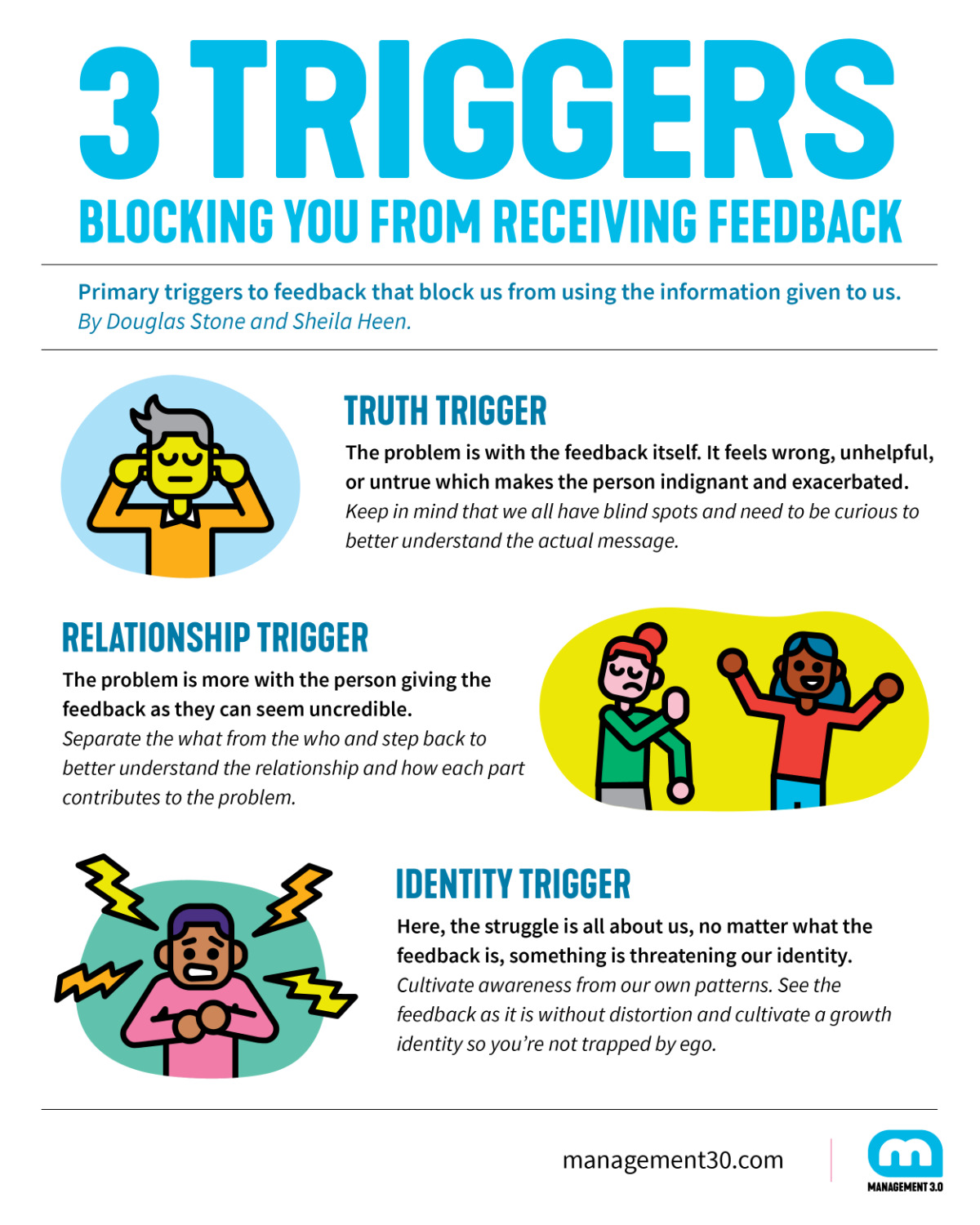An article by Management 3.0 Facilitator Lallia Cherif who has spent a lot of time and effort digging into the importance and meaning of feedback. Very early in her career Lallia conducted performance reviews, and since the first one, which was horrible, she’s done her best to improve people’s experiences Because she is aware that feedback is one of the most powerful tools, but also can be very hurtful, and therefore important for leaders to promote a healthy feedback culture.
The end of the year is approaching, which means for many employees the stressful shadow of performance reviews is looming. And guess what? It’s not only the employees that are anxious but also their managers!
Often when we think about feedback in the organization, performance reviews are the first image that come to mind, followed by a bunch of resignations. Hopefully, things are changing gradually to shift the exercise of feedback from a formal once-a-year, scary meeting scheduled in your calendar to a healthy organizational cultural behavior.
Before diving deeper into what we mean by a “healthy feedback culture,” let’s look to the past. Remember when you were at school, the most significant amount of feedback received was through good or bad grades given by the “authority”, the teacher! That’s how we were taught to give and receive feedback about performance. Perhaps that’s why many people continue to do the same at work.
By overemphasizing high-stakes evaluations as tools for reporting what students know and can do, we’ve created a culture of grading instead of a culture of feedback in our buildings.
Creating a Culture of Feedback -Use Grading to Motivate Students to Move Forward (Solutions) by William M Ferriter, Paul J Cancellieri
On the way to a healthy feedback culture: What does feedback mean – and why is it so important?
The word feedback was first used in mechanical systems before the term began to be used in industrial relations when talking about people and performance management. Literally, feedback means “feed” corrective information back to the point of origin, “the employee” (Thanks for the Feedback: The Science and Art of Receiving Feedback Well by Douglas Stone, Sheila Heen) to fix and make it more performant.
The reality is that “we swim in an ocean of feedback,” as Stone Douglas put it. And “feedback is not just what gets ranked, it’s what gets thanked, commented on, and invited back or dropped. Feedback can be formal or informal, direct or implicit, it can be blunt or baroque, totally obvious or so subtle that you’re not sure what it is.”
Nowadays, and even more in Agile teams and organizations, feedback is a vital tool in developing products, customers’ love, building resilience, developing talent, and increasing well-being in the workplace.

If feedback is that important, then why are performance reviews that hard and uncomfortable for most of us?
The first possible answer is because we are just human, and it is hard to receive bad or even constructive feedback. It triggers feelings of self-doubt, frustration, and vulnerability. Our brain responds to negative feedback or ranking with the same fight-or-flight reactions of a physical threat, which causes a “brain hijack” to give people rapid responses and aggressive movements. But ill-suited for the kind of thoughtful, reflective conversation that allows people to learn from constructive feedback according to an article in Strategy + Business magazine, titled “Kill Your Performance Rating” by David Rock, Josh Davis, and Beth Jones.
The second potential answer concerns the environment around us. Is there enough trust and psychological safety in the workplace? “Do people feel comfortable sharing concerns and mistakes without fear of embarrassment or retribution? Are they confident that they can speak up and won’t be humiliated, ignored, or blamed?” as defined by Amy Edmonson. Is vulnerability promoted or punished?
This second part is commonly associated with organizational culture, but what do we mean by culture? Is it built? Is it fixed? Do all companies have a culture? I love this definition from the Culture Code:
While successful culture can look and feel like magic, the truth is that it’s not. Culture is a set of living relationships working toward a shared goal. It’s not something you are. It’s something you do.
Daniel Coyle
Culture happens! Each organization has its unique culture, desired or not. Even more tricky, each organization has multiple subcultures (units, departments, teams …). And what is for sure is that leaders can’t write a set of values and principles and proclaim them as their culture. For me, it’s the same as for the Agile mindset, to know that values and principles is not enough, you must live them consistently in your day-to-day life, especially when things are getting harder.
Characteristics of a healthy feedback culture
Now more than ever, knowledge, creativity, and innovation have become vital sources of competitive advantage in all business sectors. To make these advantages yours, you must shift to a learning organization, and one of the most powerful ways to do it is to promote a healthy culture of feedback, where:
- Feedback-seeking behavior is the norm. Feedback is no more something to be endured but something to be actively sought.
- Feedback is no more a one-directional flow, related only to one individual, but a team sport that helps improve the whole.
- Not only performance but learning is also promoted and awarded, stories of learning are abundant and shared between co-workers.
Tips on how to establish a healthy feedback culture
Here are some tips that can help you kick off this journey.
Create an environment of psychological safety and trust towards a healthy feedback culture
One of the biggest challenges when it comes to building a safe climate lies in remembering with “mindfulness”, to be vulnerable, as well as to be interested and available for others. Amy Edmonson suggests in her book, The Fearless Organization, a straightforward and actionable set of questions to help anyone (manager or not) create more safety in the workplace:
- Express vulnerability to help others do the same by saying more often: I don’t know, I need help, I made a mistake, I’m sorry.
- Don’t miss the opportunity to express interest and availability by asking questions such as: What can I do to help? What are you up against? What are your concerns?
- Be curious, compassionate, and welcome differences, that’s what makes the magic happen inside a group (Personal Maps and Moving Motivators are perfect tools from the Management 3.0 toolkit to do so)
Read on: How can we build psychological safety to achieve more together?
To promote a healthy feedback culture, train people to receive feedback as a gift
Research about effective feedback shows that the most decisive part in a feedback relationship isn’t the givers, it’s actually the receivers. They are in control of what they hear and sense, and above all what they do with it.
We are all different and unique, which is an additional challenge in feedback relationships. Our diversity can result in misunderstanding, frustration, and lack of clarity between givers and receivers. That’s why understanding ourselves, to help others better understand us is critical. The gained confidence by doing so is the foremost step to shift receivers from push (endure feedback) to pull (seek with enthusiasm and curiosity for feedback, speak up when supportive mirrors, like additional appreciation or coaching, are needed. Or rather, seek an honest mirror when they are confused about where they stand).
Douglas Stone and Sheila Heen highlighted three primary triggers to negative or constructive feedback (we will talk about positive feedback later, but obviously, it is easier to handle, even if sometimes quite complex).
Those triggers block us from using the information given to us from the receiver and the whole context. But the good news is that they also offer a way to read them in order to overcome the perception of feedback as a threat.
Truth Trigger: The problem is with the feedback itself. It feels wrong, unhelpful, or untrue which makes the person indignant and exacerbated.
➜ Keep in mind that we all have blind spots and need to be curious to better understand the actual message.
Relationship Trigger: The problem is more with the person giving the feedback as they can seem not credible.
➜ Separate the what from the who and step back to better understand the relationship and how each part contributes to the problem.
Identity Trigger: Here, the struggle is all about us, no matter how the feedback is, something is threatening our identity.
➜ Cultivate awareness from our own patterns. See the feedback as it is without distortion and cultivate a growth identity so you’re not trapped by Ego.
Note that receiving the feedback well doesn’t mean you have to always accept it, but rather that you can engage with curiosity and lucidity in the conversation.

I often struggled with feedback, and I found this really powerful and aligned with the Management 3.0 mindset
We get better, happier organizations by changing ourselves instead of others.
Remember that regardless of the context, we are the most critical person in our own learning, and no one can stop us from it.
To promote a healthy feedback culture, train people to give feedback:
Remember that feedback is more than anything a relationship between givers and receivers, both sides must be trained!
- Always start by asking for permission to give feedback.
- Positive intent and caring. If there must be only one rule, it must be this one: Feedback must be motivated by helping the person, the team, or the company, never to hurt, to express personal frustration, or to look clever. Anyone who has been part of an agile team knows how testers become more impactful when they move from “Gotcha ! I break your code or the product” to “I help you create better products.”
- Use belonging cues: If there is one desire that can balance or stop the learning needs, it is the human’s need and desire for acceptance and belonging to the group. That’s why it’s essential to use belonging cues when delivering feedback. It can be as simple as saying: As part of this team, or simply a tiny gesture like using an appreciative tone.
- Overcome your own identity biases: Know your own pattern, and most of all, be curious about your co-workers to give them the feedback that suits them best, not the one that you want to have.
- Shift from conflict avoidance to embracing healthy discussions: Often, feedback givers and especially managers lack the courage to give honest and constructive feedback. That’s why it’s important to help your people understand the why and the benefit of the feedback for the receiver in the long-term instead of focusing on the short team discomfort.
- Be as specific as possible on what isn’t going well, how it affects you, and why you think so. The Management 3.0 Feedback Wrap is a perfect tool to achieve that.
- Finally, my favorite one from the Coaching Habit book, Shift from advice-giver to coach-like behaviors: Again, the secret sauce is being curious and asking powerful questions to help the receiver discover by himself what is going on and how to move forward. Of course, it’s easier said than done, we are all serial advice-givers.
Lead by the example, talk often about feedback, and make it a habit to promote a healthy feedback culture in your organization
Leaders must lead by example by developing feedback-seeking behaviors and making them visible.
It’s also vital to create room for feedback in day-to-day life. As we all know, it’s not easy to build new habits, but it’s pretty easy to manage a week or a meeting. It can be done by:
- Adding slots for leadership or mutual feedback in one-on-one meetings.
- Facilitate Lean Coffee sessions to answer questions or discuss struggles about feedback and make sure everyone’s voice is heard.
- Reinforcing and maintaining Agile teams retrospectives (many Management 3.0 practices can be used to do it)

Separate appreciation, coaching, and evaluation to promote a healthy feedback culture
Often mixed appreciation, coaching, and evaluation are three different feedbacks that aim to achieve different results, it’s crucial to know how to separate them.
Appreciation is often the forgotten part of the feedback process, people focus too much on the negative, or they are sometimes mixed. It’s proven that having a cultural norm of appreciation that encourages everyone to notice the genuine and unique positives in a co-worker, makes him reinforce them by better understanding and seeing patterns in his own excellence. Always with diversity in mind, remember that appreciation can be suited in different forms from a person to another. Kudo Cards and Kudo Walls are good examples for promoting mutual appreciation.
When evaluation must be fair and consistent, coaching requires trust and vulnerability to be effective, which is impossible if it’s tied to bonuses, salary, or threatening in any manner the receiver’s job security or career.
To promote a healthy feedback culture, engage co-workers in framing the organization feedback system
In the same way, as for an Agile Transformation, there is no magical recipe or a perfect system for performance evaluation, it must suit your specific needs and culture. But to build the best one for your organization, it’s important to explain the benefits and most of all, invite for feedback and discussion in a co-creation mindset. Engaging people and co-creation work are parts of the Management 3.0 principles.
Build on agile team’s accountability and make feedback a team sport to promote a healthy feedback culture
Agile team members are by definition accountable to one another, by always looking at how they can improve as a team to deliver the most valuable outcome, they naturally apply peer-to-peer pressure for continuous improvement to never let their team down.
Another advantage of giving feedback inside a group, like during team during retrospectives, for example, is that the value of the feedback collected often increases exponentially because people build on each other’s observations and suggestions. The 360 Degree Dinner of Management 3.0 helps explore that.
Finally, moving evaluations from an individual to a team perspective, reinforce collaboration and the sense of a shared goal and mission and avoid suboptimization by considering individuals, teams, and their interactions.
To promote a healthy feedback culture, reinforce positive behaviors and never tolerate toxic or bad ones
Trust and psychological safety are hard to create and so easy to lose! As a leader, it’s your duty to keep your eyes open make sure that no one is bad or disrespectful to another, even your most brilliant employees, those that you think are too important to risk losing.
The culture of any organization is shaped by the worst behavior the leader is willing to tolerate
Gruenter & Whitaker
That said, we often focus too much on bad behaviors and forget that one of the best ways to avoid them is to make the good ones visible as much as possible, to create positive mimetic behavior inside the organization.
Don’t let feedback go unheard
When people care about their company and their co-workers, they take the time and the courage to share their feedback, looking for impactful positive changes. Be sure as an employer and as a leader that these people feel heard and seen and engage in good discussions, or you will lose them! The need and desire for influence can be strong motivators for many of us.

It’s clear that promoting a healthy culture of feedback is not an easy task and requires the contribution of everyone. To help you navigate and better understand the importance of a good feedback culture, at Management 3.0 we have a full module on Better Feedback, which contains simple and actionable tools to train people to give feedback as the Feedback Wrap. It fosters authenticity, positive reinforcement, a sense of purpose, and clarity and it’s part of the Agile Team Leadership Workshop as well as the Agility in HR Workshop.


